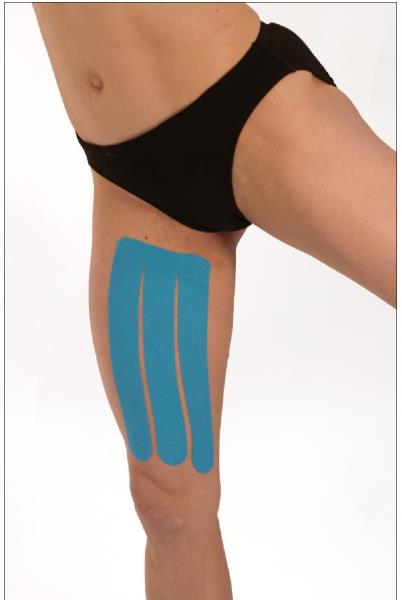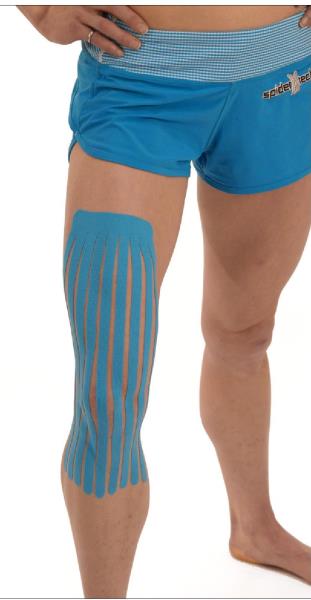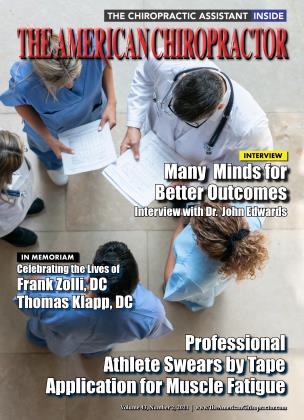“The goal of Neurosensory Application is to stimulate the myelinated mechanoreceptors in our skin...”
One of my favorite characteristics of kinesiology tape is its Versatility. Whether the treatment goal is pain control, postural improvement/correction, or acute injury rehab, when a patient walks out of your office wearing kinesiology tape, they walk out with a continuation of care. Kinesiology tape is the treatment between treatments. The inspiration for this article on kinesiology tape and muscular fatigue stems from my experience working on the ATP Tour but this usage is relevant for athletes of all levels.
We can all agree that muscular fatigue affects performance. It increases reaction time, posture sway, and decreases motor acuity, all adaptations that decrease body control and increase the incidence of injury. If kinesiology tape as our treatment between treatments could counteract the negative effects of muscle fatigue it would be an invaluable tool on the court and in our offices. In this article, we will look at how to use kinesiology tape to prevent injuries when patients are experiencing muscle fatigue by aiming to improve their balance and proprioception.
Neurosensory Application

When Applying: Stretch The Muscle Not The Tape
The goal of the Neurosensory Application is to stimulate the myelinated mechanoreceptors in our skin to increase the afferent input to our CNS. In doing so, we increase our brain's awareness of our body in space through additional tactile stimulation provided by the tape pulling on the skin3. When our body is in a state of homeostasis, this supplemental information may not be required, but when fatigued our nervous system benefits from additional information to restore proprioceptive acuity and neuromuscular control4. Muscular fatigue commonly degrades muscle spindle and Golgi tendon activity. This causes a blurring of the afferent information traveling to the CNS and requiring a greater postural movement to inform the brain about position in space. This pattern helps explain why fatigue has been shown to significantly increase reaction time, postural sway, and the risk of injury1, 2, 3.
Lymphatic Application
When Applying: Stretch The Muscle And Stretch The Tape With 10% Tension

The benefits of the Lymphatic Application arise from the combination of neurosensory stimulation with the enhanced function of the lymphatic channels underlying the skin. This application aims to elevate the skin and its anchoring filaments to decompress the lymphatic channels within the oedematous tissue2. This action promotes the removal of metabolic waste such as lactic acid and organ compounds such as histamine and bradykinin, thereby reducing their effect upon our proprioceptive receptors2. This application also creates a tissue environment where regions of high pressure (intervals between the kinesiology tape) will allow edema to gravitate to the regions of lower pressure (taped areas) allowing for a proximal movement of fluid2.
When deciding which application to apply I follow these guidelines.
1. If there is visible edema, the Lymphatic Application is the first priority.
2. When working with athletes/patients who are about to engage in an activity that is likely to cause muscle fatigue, I would opt for the Neurosensory Application.
3. When a patient is experiencing a self-reported high level of muscular fatigue from a low intensity, high volume activity like desk work, I initially use the Lymphatic Application. I find in this presentation, a micro-level of tissue edema plays a significant role, and initially, I aim to impact tissue congestion and fluid transfer as much as possible.
Looking at the Scientific Research we see that the use of kinesiology tape to counteract the detrimental proprioceptive effects of muscle fatigue is strongly supported provided two variables are met:
1. The muscle is sufficiently fatigued4,5,6
2. The area that is fatigued is the area that is taped1, 2, 3, 4, 5
Zulfikri et al. taped the quadriceps, hamstrings, and calf in young, healthy, recreational athletes1. Kirmizigil et al. taped the quadriceps and knee of recreational athletes 21-36 years old2. Hosp et al. in two different studies taped the quadriceps and knee of geriatric men3 and healthy young women4 and Thedon et al. taped the Achilles tendon of healthy men and women in their early 20s5 and all studies concluded that when muscle fatigue is present, using kinesiology tape counteracts the negative effects and helps to restore balance and proprioception.
Dr. Nick Martichenko, DC is the Director of Education for SpiderTech kinesiology tape in Toronto, Canada. He is Head of Manual Therapy and Strength & Conditioning for Golf Ontario's Development Programs, a member of Denis Shapovalov's Performance Team, and a member of Tennis Canada's Junior Development Program Performance Team. Contact Nick at [email protected]
References:
1. N. Zulfikri et al. Effects of kinesio taping on dynamic balance following fatigue: a randomized controlled trial. Pliys Tlier Res (2017).
2. B. Kirmizigil et al. The effectiveness of kinesio taping in recover from delayed onset muscle soreness: a crossover study. J of sport Rehab (2019).
3. S. Hosp et al. Does Kinesiology tape counter exercise-related impairments of balance in the elderly? Gait & Posture 62 (2018) 167-172
4. S. Hosp et al. A pilot study of the effect of Kinesio tape on knee proprioception after physical activity in healthy woman. J Sci Med Sport (2014).
5. T. Thedon et al. Degraded postural performance after muscle fatigue can be compensated by skin stimulation. Gait & Posture 33 (2011)686-689.
6. T. Halsetli et al. The effects of Kinesio taping on proprioception at the ankle. JSSM(2004); 37(1): 19-24
 View Full Issue
View Full Issue









